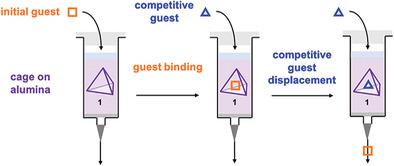当前位置:
X-MOL 学术
›
Adv. Mater.
›
论文详情
Our official English website, www.x-mol.net, welcomes your feedback! (Note: you will need to create a separate account there.)
Guest Encapsulation within Surface‐Adsorbed Self‐Assembled Cages
Advanced Materials ( IF 29.4 ) Pub Date : 2020-11-25 , DOI: 10.1002/adma.202004192 Hugh P Ryan 1 , Cally J E Haynes 1 , Alyssa Smith 1 , Angela B Grommet 1 , Jonathan R Nitschke 1
Advanced Materials ( IF 29.4 ) Pub Date : 2020-11-25 , DOI: 10.1002/adma.202004192 Hugh P Ryan 1 , Cally J E Haynes 1 , Alyssa Smith 1 , Angela B Grommet 1 , Jonathan R Nitschke 1
Affiliation

|
Coordination cages encapsulate a wide variety of guests in the solution state. This ability renders them useful for applications such as catalysis and the sequestration of precious materials. A simple and general method for the immobilization of coordination cages on alumina is reported. Cage loadings are quantified via adsorption isotherms and guest displacement assays demonstrate that the adsorbed cages retain the ability to encapsulate and separate guest and non‐guest molecules. Finally, a system of two cages, adsorbed on to different regions of alumina, stabilizes and separates a pair of Diels–Alder reagents. The addition of a single competitive guest results in the controlled release of the reagents, thus triggering their reaction. This method of coordination cage immobilization on solid phases is envisaged to be applicable to the extensive library of reported cages, enabling new applications based upon selective solid‐phase molecular encapsulation.
中文翻译:

表面吸附自组装笼内的客体封装
协调笼在解决方案状态下封装了各种各样的客人。这种能力使它们可用于催化和贵重材料的封存等应用。报道了一种在氧化铝上固定配位笼的简单而通用的方法。通过吸附等温线和客体置换试验对笼子负载进行量化,表明被吸附的笼子保留了封装和分离客体和非客体分子的能力。最后,一个由两个笼子组成的系统,吸附在氧化铝的不同区域,稳定和分离一对 Diels-Alder 试剂。添加单个竞争性客体会导致试剂的受控释放,从而引发它们的反应。
更新日期:2021-01-04
中文翻译:

表面吸附自组装笼内的客体封装
协调笼在解决方案状态下封装了各种各样的客人。这种能力使它们可用于催化和贵重材料的封存等应用。报道了一种在氧化铝上固定配位笼的简单而通用的方法。通过吸附等温线和客体置换试验对笼子负载进行量化,表明被吸附的笼子保留了封装和分离客体和非客体分子的能力。最后,一个由两个笼子组成的系统,吸附在氧化铝的不同区域,稳定和分离一对 Diels-Alder 试剂。添加单个竞争性客体会导致试剂的受控释放,从而引发它们的反应。



























 京公网安备 11010802027423号
京公网安备 11010802027423号